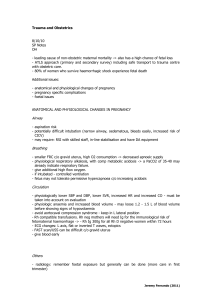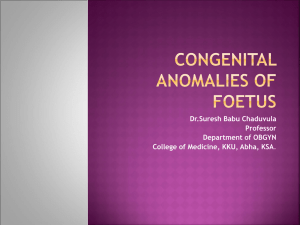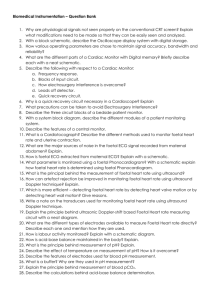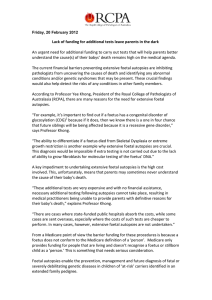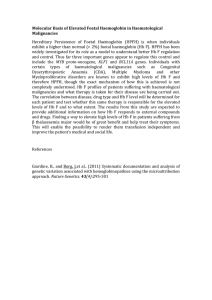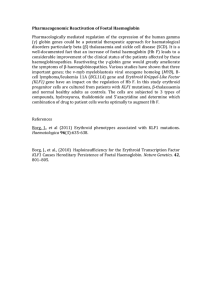Lecture Notes on Veterinary Obstetrics, VCT 601 (PPT) BY DVM,MVSc
advertisement
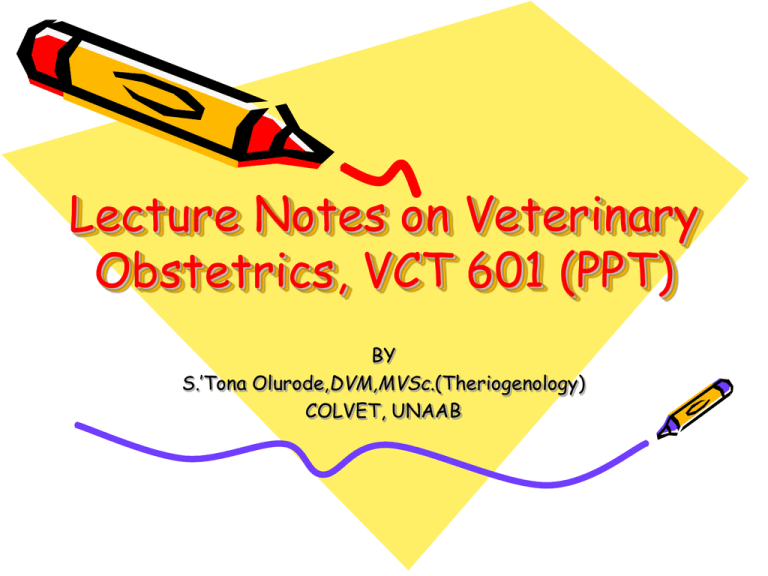
Lecture Notes on Veterinary Obstetrics, VCT 601 (PPT) BY S.’Tona Olurode,DVM,MVSc.(Theriogenology) COLVET, UNAAB BOVINE PREGNANCY AND ITS DIAGNOSIS • • • • Indication for Bovine Px Dx: to detect those non-pregnant so that appropriate measure(s) can be taken. NB: Age at 1st calving is approx 24mos for dairy cows and subsequently at 13-13.5mos intervals After ~60days post insem foetal death rates are low Pregnancy diagnosis • 1. 2. 3. 4. Methods used grouped under the following subheadings: Management Chemical or laboratory method Clinical examination Ultrasonography Managemental methods of px dx • Non-return to oestrus and CL persistence • History of exposure of cow to a bull or A.I. • Mammary gld devpt (useful only in primigravida) • Abdominal ballottment possible at ~7mos of gestation in small breeds such as jersey Chemical or Laboratory methods • EPF/ECF demonstration in serum or milk via commercial test kits using the ‘dip stick’ principle; early in 3days or later in 78 days • Progesterone assay in plasma & milk using RIA or ELISA. Blood sample collected 21days post previous oestrus. • Assay of px-specific protein B via RIA good tool for twins identification • Oestrone SO4 in milk Clinical methods • Transrectal palpation, can be done as early as 30days in heifers and 35days in cows. (disadvantages – much practice is reqd) -uterine assymmetry -membrane/foetal slip (see table 1 for the ‘rule of thumb’) Table 1: Calf foetal size at various stages of pregnancy in relation to the size of some commonly known adult animals. Stage of pregnancy Calf foetal size in relation to the size of commonly known adult animals 2 months Mouse 3 months Rat 4 months Small cat 5 months Large cat 6 months Beagle dog position/diameter and structures during pregnancy Stages of Pregnancy (days of gestation) Uterine position Uterine diameter Palpable structures 35-40 Pelvic floor Slightly enlarged Uterine asymmetry/foetal slip 45-50 Pelvic floor 5.0-6.5cm Uterine asymmetry/foetal slip 60 Pelvis/abdomen 6.5-7.0cm Membrane slip 90 Abdomen 8.0-10.0cm Small placentomes/foetus (10-15cm long) 120 Abdomen 12cm Placentomes/foetus (25-30cm long)/fremitus 150 Abdomen 18cm Placentomes/foetus (35-40cm long)/fremitus Clinical methods contd’ • Vaginal examination using either of the following ways: • visually with the aid of vaginoscope • manually through pressing the finger directly on the external os of the cervix to detect the presence of an adhesive tenacious secretion Ultrasonography • Requires ultrasonic foetal pulse detector that employs the Doppler principle. 2 types are available; • ultrasonic depth analysers (A-mode) with disadv of questionable degree of accuracy as early as 40days • Realtime B-mode method of choice for early px dx in the cow via transrectal imaging • For early pxs 7.5MHz linear transducer is reqd while late pxs prefers 3.5MHz transducers • Useful in foetal age estimation (assmt of trunk diameter) up to 140days,CRL not easy to assess; sex determination via migration of genital tuberclein male, migration is towards the umbilicus whereas in the female, it is towards the tail Normal Birth in the cow (Eutocia) • Normal birth process= calving • GL averages 290 days, sequel to series of events emanating from the initiation of parturition Preparatory changes are those associated with the udder, vulva and pelvic ligaments, body Tº drops 24-48hrs b4 calving, exudation of clear vaginal mucus,tail head might appear raised with gluteal muscles sunken LABOUR Slide 4 of 56 Stage 1 of labour Slide 5 of 56 Stage 2 of labour Slide 7 of 56 Stage 3 of labour Events of the 3 stages of labour • 1st stage – cervical dilatation or dilation, the duration is about 3-8 hours in cows but longer in heifers, 24hrs. The cardinal sign is restlessness • 2nd stage – foetal delivery, the duration averages 2-4 hours in pluriparous cows but longer in heifers, involves straining by the dam • 3rd stage - placental expulsion, time reqd averages 8 hrs but can last 12hrs sometimes which is still considered normal. DYSTOCIA Slide 9 of 56 Causes of Dystocia For convenience, causes are divided into 2: 1. Maternalprimary uterine inertia- ocassioned by multiple or abnormal foetuses which overstretch the uterus, a defect in the myometrium that renders contraction impossible, hormonal defect and periparturient hypocalcaemia. Dam may exhibit few weak abdominal contractions that fail to progress to 2nd stage. On exam.,cervix is found dilated with no foetus in the birth canal. Treatment via gentle traction and correction of position and postural defects. secondary uterine inertia – consequent upon myometrial exhaustion. Possible sequelae include retained placenta, delayed uterine involution and uterine prolapse. Treatment is by removal of the impediment. abnormalities of the birth canal-inadequate pelvis, pelvic exostoses, incomplete cervical dilatation, vaginal cystocoele, neoplasms of the vulva and vagina, remnants of mullerian ducts persisting, uterine torsion, stenosis of the vulva and vagina (heritable in some breeds or due to immaturity. 2. Foetal i. Abnormal foetal presentation, position and posture ii. Foetal monstrosities- Schistosoma reflexus, perosomus elumbus e.t.c. iii. Foetal oversize – most common cause in cattle due to foetopelvic disproportion Obstetrical Procedures Divided into 4 main groups viz. 1. Mutation- includes repulsion, rotation, eversion, extension or adjustment of the extremities. Useful to return a foetus to normal P. P& P. 2. Forced traction 3. Embryotomy 4. Caesarian section Lambing & Kidding • GL ~ 140-150 days on the av.140 days for sheep • Prior to EDD, ewe shd be put on observation every 4-6 hours to check for certain conditions like pregnancy toxaemia, hypocalcaemia, vaginal prolapse, abortion, mastitis & rupture of the prepubic tendon. Stages of parturition – consult the note! Causes & Mgt. of dystocia in sheep and goat • Goat – parturition normally uneventful. If labour extends beyond 30 mins, consider dystocia. • Most common forms arise when more than one kids attempt to exit the birth canal at the same time. Other causes are deviation from normal PPP, foetomaternal disproportion, failure of cervical dilatation (ring womb), vaginal prolapse, uterine torsion and uterine inertia. Causes & Mgt. of dystocia in sheep and goat cont’d • • • 1. 2. 3. 4. Mgt – dx based on failure of active labour to be initiated and history. NB: if no delivery accomplished within 2-3 hrs, the cervix will start to close. Protocols of mgt requires: Strict adherence to general principles of cleanliness, lubrication and gentleness Use of appropriate restraint techniques ± epidural anaesthesia Relief of dystocia Infectious causes of abortion • Goats tend to have high incidence of abortion when compared to other livestock species. • Infectious causes of abortion is highly significant. However, all or none principle is assumed during an abortion outbreak i.e. all causes of abortion are infectious in nature • 1. 2. 3. 4. 5. 6. 7. 8. 9. 10. 11. 12. 13. Infectious causes of abortion, therefore, include the following: Chlamydiosis Toxoplasmosis Q-fever Listeriosis Leptospirosis Mycoplasmosis Campylobacteriosis Brucellosis Salmonellosis Yersiniosis Trypanosomosis Sarcocystosis anaplasmosis Non-Infectious causes of abortion • Early embryonic death- due to several physiologic or environmental factors sequel to predisposing factors e.g. stress, nutrition etc. • Genetic disorders- habitual abortion may be heritable or cross resulting in abnormal chromosomes • Nutritional factors- deficient E & protein in the diet most esp in the late gestation • Toxic plants and pharmaceuticals POST-PARTUM DISEASES • Uterine prolapse • Vaginal prolapse • Acute septic metritis (puerperal metritis) • Mastitis • Retained placenta Foetotomy (Embryotomy) • Term used to describe method of dividing the foetus into smaller pieces to ensure easy passage thro’ the birth canal. • Commonly employed in cattle, occasional in horses, rarely in sheep & goat and almost never in pigs and small animals. The technique is a method of choice esp when foetus is ascertained to be dead in utero. Classification of Foetotomy • 1. 2. • 1. 2. 2 classes basically, viz; Complete/ Total Incomplete / Partial 2 techniques available Percutaneous foetotomy Subcutaneous foetotomy Percutaneous foetotomy • Requires a tubular embryotome which confers protection on the maternal tissues against damage while sawing through the dead foetus • Preferred method for nondecomposed foetuses Subcutaneous foetotomy • Involves dissecting out foetal parts from within its skin to cause reduction in foetal bulk and allowing the delivery of the remainder mass par vaginum. Indications for complete foetotomy • Relief of dystocia caused by foetal maldisposition • Relief of dystocia caused by foetopelvic disproportion (foetal oversize, foetal monsters) • Relief of dystocia caused by engaged foetus within the birth canal e.g. stifle lock (hip lock) • During CS when large or deformed or maldisposed foetus is encountered Indications for partial foetotomy • Deviation of the head • Shoulder flexion • Breech presentation (bilateral hip flexion) • Posterior presentation (hock flexion) • Foetal monsters • 1. 2. 3. 4. 5. Care of the dam following foetotomy include : Manual exam of vagina and uterus Administration of local and parenteral antibiotics Non-steroidal anti-inflammatory therapy Careful removal of the placenta from the caruncles Careful nursing Thanks for your attention
